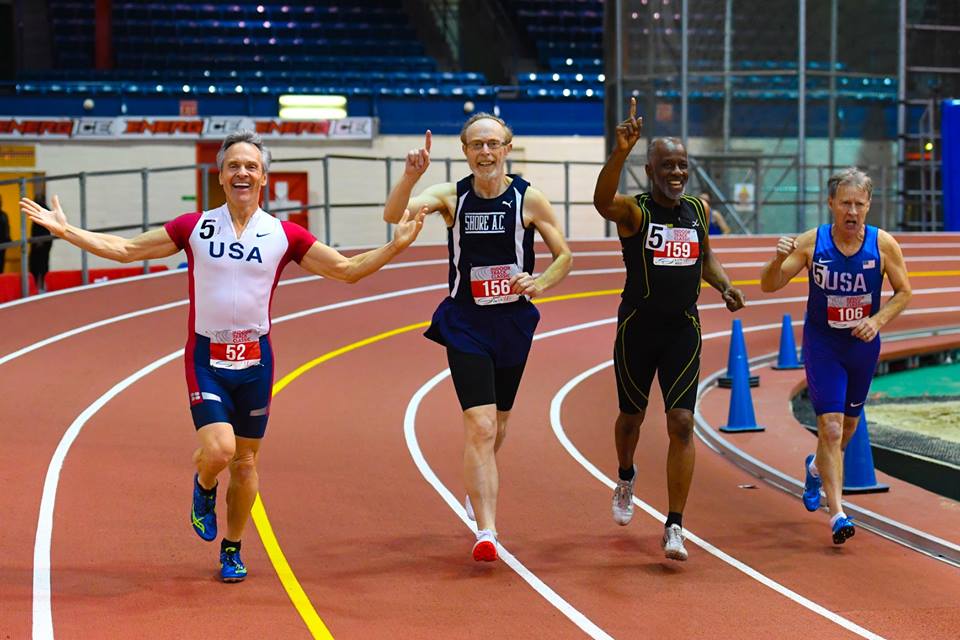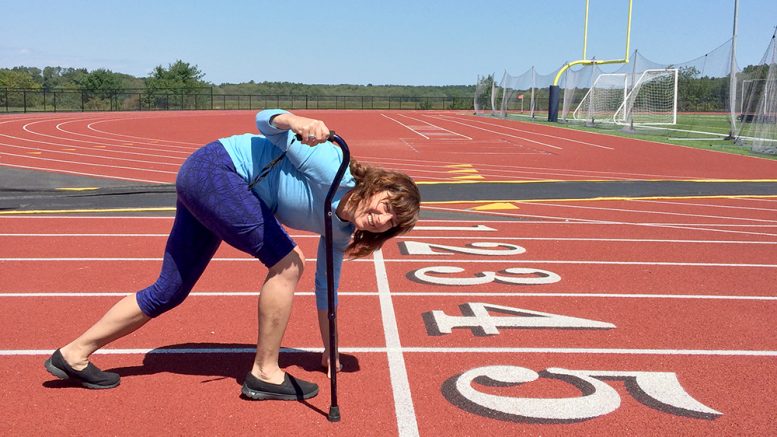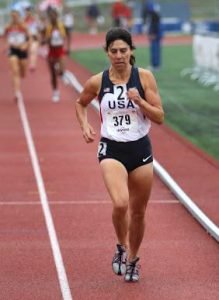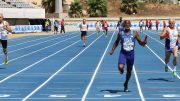World sprint champ Roger Pierce is well-known to readers of this blog. He’s been a Masters Hall of Famer for 10 years. But lately I’ve been more intrigued by his W50 wife of three years — Diane Tedford Pierce. On Facebook, I followed her progress in coming back from knee surgery. When someone suggested I interview her, I jumped into action. Her backstory is impressive, too. Diane — who bought a house with Roger and moved to Rowley, about 10 miles north of Essex in 2015 — graciously responded.
Masterstrack.com: Where were you born, and where did you grow up?
Diane Tedford Pierce: I was born in Pittsfield, Mass., and grew up in Dalton, a small town in the Berkshires. I loved running as a child and often raced my older brothers and other neighbors on my street where I grew up. I started formally running when I was a freshman in high school on the Wahconah Regional High School cross country team.
What are your all-time track and running PRs? Any major youth titles?
In high school, I ran both cross country and track. We didn’t have indoor track in my area. In high school, my best times were 2:22 for the 880, 5:08 for the mile, 11:37 for 2 miles. My only 400-meter experience was anchoring the mile relay. I was All-State in both cross country and track. I placed 9th in the All State Cross Country Meet and fifth in New Englands in the mile as a senior. We had a great team and coach Al Devereaux. Our boys teams won numerous Western Mass. titles and our girls team were Berkshire County co-champions my senior year.
In college, I ran at Bryant College, a Division II school in Smithfield, Rhode Island. I won numerous invitationals during college in both cross country and track. I placed 15th in the 1986 NCAA Cross Country Championships in Riverside, Calif., making All-America status. I ran two seasons of track in college and three seasons of cross country. My best times were 2:14 for the 800, 4:35 for the 1500, 9:47 for 3000 and 16:56 for 5000 meters.I ran for Reebok my junior and senior years in college where I competed in cross country, indoor track and on the roads. Ioften trained 60-80 miles per week. My best road times were 16:50 for 5k, 35:37 for 10K, 1:20:03 for half marathon and 2:54:09 for the marathon. I continued running competitively after college for several years. In 1995 and 1996, while competing for the Boston Athletic Association, I ran six marathons under the training of my high school coach, Al Devereaux. I won the Ford Buffalo Marathon in 1995 (which was my first marathon), placed third in both the San Francisco and Cape Cod Marathons, and 35th in the USATF National Marathon Championships in Duluth, Minn. I ran competitively until about 1996 and then coached several other athletes. I continued running but did not compete at this time.
I had my daughter, Alyssa, in 2002. I ran early in the pregnancy but stopped due to spotting. I had complications at 23 weeks and was hospitalized on bed rest for one month until she was born at 27 weeks. Due to the difficult pregnancy, I ended up gaining about 50 pounds. I found it very difficult to lose the weight. I started running about two weeks after giving birth, but the weight did not seem to be coming off that easily.
In 2010, I read an article about masters track. I was completely unaware that there were organized races for masters athletes. I wanted to lose more weight, so I began training for the mile. My goal was to break 6 for the mile. First I ran a few road races to try to get back to some aerobic shape. I competed at the Empire Liberty Games series in Albany, NY, which was about an hour from my home. I planned to run the 800 and 1500 the first meet despite not having run on the track in many years.

Roger Pierce (right) recently helped set an M70 world record in the 4×400.
Due to the lack of indoor tracks in the Berkshires and the demands of my job as a nurse practitioner, I trained entirely on a treadmill during the winters of 2011 and 2012. I was surprised at how well I ran during those seasons. I won the 2012 indoor 800 meters and placed second in the 400 at the indoor nationals in Indiana.
When and how did you meet Roger?
I competed at the East Region USATF Masters Championships in Providence, R.I., in 2011. I won the 800 and placed third in the 400. I was asked by Tucker Taft to run on the girls Mass Velocity 4×400 relay for the meet. I had also met a few athletes at the Open New England Championships a few weeks before and they were really friendly. I saw the Mass Velocity athletes at many of the meets. They had never had a team at the Penn Relays and were looking for more women to join their team. I thought that this would be a great experience so I joined the team in the spring of 2011.
During the outdoor season in 2011, I first met Roger on the infield at the outdoor nationals in Cleveland. He was living in Essex, and I was living in the Berkshires, three hours away. He was cheering on other members of our team and then came up to me and said, “I’ll tell you how to run this race. You have to go out hard.” I told him that I was a distance runner, not a sprinter. He said, “Just Do What I Say.”
I figured that he rarely loses any of his races, so I went to the starting line ready to run hard early. I really knew deep down that this wasn’t the best approach since you have to do in practice what you plan to do in a race. I got out hard and was leading at 200 meters. By 300 meters, Kris Kazebee from North Carolina had pulled up along side me. I felt that I was all done. Roger was standing there and yelled: “Don’t you dare quit.”
I was extremely tired and seemed unable to move but dug way down and kept running. Kris was also tired. We both passed each other several times in the final 50 meters. I don’t even remember parts of this race. At the end, I dove and fell face down on the track and won the race by a few tenths of a second. I laid there on the track. Roger came over and picked me up.
I thanked him for helping me win the nationals and then jogged off. I didn’t see him until the next year, which was the indoor season of 2012. I spent a lot of time with my MV teammates while in Indiana. After winning the 800 and placing second in the 400 after training entirely on the treadmill, I asked him about sprint training. I told him that I was going to go home and hire a high school coach to help me. He offered to coach me via phone calls and emails.
I started his training program one week after nationals. I had run 66.1 as my best 400 up to this point. In college, I ran the 400 only once in a race and ran 62. My goal was to break 66 and 2:30 in the 800. After 2.5 weeks of his program in which I ran only 10 miles per week compared with 35-45 miles per week which I was doing previously, I ran 64.7 for the 400.
He ended up coming to the Berkshires a few times in the spring. This is when our relationship started. He was divorced. I was in a horrible relationship at the time. I ended up moving to Beverly, Mass., in June 2012. That year, I kept improving every race and after two months, I had run 28.28 for the 200, 61.7 for the 400, and 2:23 for the 800.
At the last meet of the season, I wanted to try new races off of my sprint training. I ran a 14.15 for the 100 and then followed it with a 5:03 1500 meters at the New Hampshire Senior Games. My long run at the time was only 1500 meters, but I felt that my prior training had helped me plow through the race. In 2013, I kept improving indoors and lowered my 400-meter time down to 61.5 and 2:22 for 800 meters. One of my proudest moments was a third-place finish in the W45 400-meter final at the WMA Championships in Brazil.
What are your main events now?
Due to my knee injury, I am unable to run a lot of distance. I am hoping to compete in the 200, 400 and 800 meters. I have been mixing it up in training running distances from 50 meters to the 600.
How did you come to require knee surgery?
I tore my right meniscus back in 1989. At the time, I was on crutches and a knee immobilizer. After six weeks, my knee got better (after I snuck in a few mile runs on soft grass). The surgeon told me that I could avoid surgery if I kept the muscles around my knee strong. At the end of the 2012 season, I had pain in my right knee.
One month before the WMA World Championships in Brazil, my knee got worse. It was popping when I was walking, but it never hurt when I was running at full speed. I had entered the 400 and 800 in Brazil. The surgeon told me that it was my meniscus. I told him that I would deal with it when we got back from Brazil. He gave me a cortisone shot and I ran the 400 and 800 meters. I placed third in the 400 meters and fifth in the 800-meter final.
I had meniscus surgery on Dec. 31, 2013. I was told that I had a dime-size area of arthritis. After the surgery was over, I was told that the bone was debrided. After this surgery, I had difficulty bending my knee more than 90 degrees. I had pain and it kept swelling up. I saw four other surgeons and was told that they could only do more surgery.
They offered to do an osteotomy, but they told me that they were unsure if it would help. I had a few cortisone shots and then I saw an 80-year-old women at my practice who told me that she had her own blood injected into her knees and that she can now walk 30 minutes a day.
I looked into this and found Dr. Navid Mahooti at Mass General in Danvers. He specializes in nonsurgical treatment for sports injuries and does PRP (platelet rich plasma) injections. I had PRP injections in both knees; however, the damage on my right knee could not be fixed.
The injections kept it from swelling up, but I still had a leg length discrepancy and my knee would flop around when I was running. I knew in 2016 that I would need surgery when Dr. Mahooti basically told me that I would be lucky if I had one more year on my right knee. Each year, my muscles started to atrophy and I kept getting slower despite my training.
When and where was surgery? What exactly was done?
I researched various techniques and surgeons who performed knee replacements and found a great one in Boston, Dr. Wolfgang Fitz at Brigham & Women’s. He was one of five surgeons who came up with the Conformis custom knee implant. The company is based in Burlington, Mass., which is about 25 miles away from here.
I had the surgery Aug. 14, 2017. Roger and I ran at the NCCWMA Championships in Toronto on Aug. 12 and 13. I entered the 100 and 200 thinking that I would run the prelims only. I was surprised that I made the finals of both. I also ran on the USA 4×100 team.
We arrived home on Aug. 13 at 8 pm. By 8 the next morning, I already had an IV in my arm. I was able to walk with a walker down the hall and into the bathroom two hours after I came back from the recovery room. I was discharged the next day with home physical therapy for the first two weeks. I could bend it 100 degrees two days after surgery.
How did you rehab from surgery?
I completed six weeks of outpatient physical therapy and biked up to 30 minutes for the first few months. The PT used cupping, massage, strengthening and ROM to keep bending my knee. I progressed to about 110 degrees during this time.
I initially tried jogging 100 meters in October. It took me 27 seconds. I had difficulty moving my right leg. It felt like I’d had a stroke. I kept trying to run and started easy jogging for 5-10 minutes at a time. I slowly improved. I did some running on the treadmill and kept doing my physical therapy exercises, had a few sessions of deep tissue massage and kept using the cold laser.
I also initially used electrical stimulation to try to refire the muscles in my right leg. I never thought that I would be able to run faster than a 20-second 100 ever again. In November, I ran a 19.3 and had tears in my eyes. By the end of February, I could run a 100 in 17.9 and 200 in 40 seconds. I now run two track workouts per week, do some easy jogging 10-20 minutes of soft surfaces, do weight training (including exercises on our Bowflex to continue strengthening my right hamstring and quads. In the past month, I have been able to run 15.3 for 100 meters, 32.5 for 200 and 54.4 for 300 all with a running start.
What was first comeback meet like?
My first race was in May at the Connecticut Masters Games. I was concerned about my leg being stiff because it was held in the pouring rain. I ran the 50 and 100 in 8.6 and 16.1. I had no idea what to expect but wanted to run better than 17 seconds.
Goals for season? Major meets upcoming?
My goals for this season are just to keep running and keep trying to get faster. There is no way to tell what my limitations are. My right knee can bend only up to 120 with some applied pressure while my left can flex 140 degrees. I also have difficulty trying to move it laterally.
Roger and I will be competing in the upcoming Bay State Games and plan to run at the 2018 WMA Championships in Malaga. I would not be going if Roger wasn’t going to compete. We’ll use it as vacation and plan to travel to Italy the week after the meet.
How is Roger helping in your comeback?
Roger is always by my side helping me. He helps me with ROM and deep-tissue massage. We both train together. He is always encouraging me. He gives me a head start during our intervals now so we’re finishing about the same time. This way, I can also help him run faster.
Any advice for other masters contemplating knee surgery?
I feel that less is more when it comes to knee surgery. I regret having my initial surgery now because it basically ruined my knee. It caused my knee to become weak and unstable and caused a leg length discrepancy. I tried everything that I could to fix it on my own but was unable to do so. Unless you have severe arthritis or your knee locks up or gives out, I would recommend cortisone shots, rest and PRP injections first.
For those contemplating a total knee replacement, the technique has improved drastically in the past 20 years. My first nursing job was on an orthopedic floor. I took care of numerous patients who had TKRs. These patients were often hospitalized 5-6 days, had a CPM machine, were on blood thinners and were in excruciating pain.
Many were discharged to rehab facilities to continue their therapy. Dr. Fitz used compression boots instead of blood thinners and a spinal block instead of general anesthesia. This allowed me to start my physical therapy right away. I took Tylenol 1000 mg, Naproxen 500, gabapentin 300 mg and half of a Tramadol for the pain. I was in pain for the first month, but it slowly improved.
I have been in contact with a few fellow masters runners about my experience. Most surgeons don’t recommend running after a TKR. There are a few surgeons including Dr. Kevin Stone at the Stone Clinic and Dr. Eric Heiden, the former Olympic speed skater. Dr. Heiden does TKR on masters skiers so that that they can return to the slopes.
Anything else readers should know about your injury, surgery and comeback?
If you have any questions about knee surgery, feel free to contact me. (Write me, and I’ll forward to Diane.)
Contribute to support independent track and field journalism:





I have been following Diane’s journey closely. She has progressed amazing well. But as a superior athlete along with her hard work, that’s to be expected. My right knee is an identical twin of hers, though I have been contemplating a PKR (partial). The replacement for Diane’s knee via 3-D printing is technology at its best for us geezers. Give ’em hell in Malaga Diane ( & Roger!)
Thanks for this article on Diane Ken.. She is a warrior.. Hopefully her experience will give others hope for their own future in Track if they are dealing with Knee issues..It ain’t over til it’s over!!! NEVER SAY DIE.. congratulations on your “Retirement” Ken and good luck with the blog.. Keep writing and researching buddy..Love your stuff..
Great interview. Having had ACL knee surgery, I agree that less is more. Wish I would have known that 5 years ago. The body heals itself well but it can’t heal what isn’t there anymore.